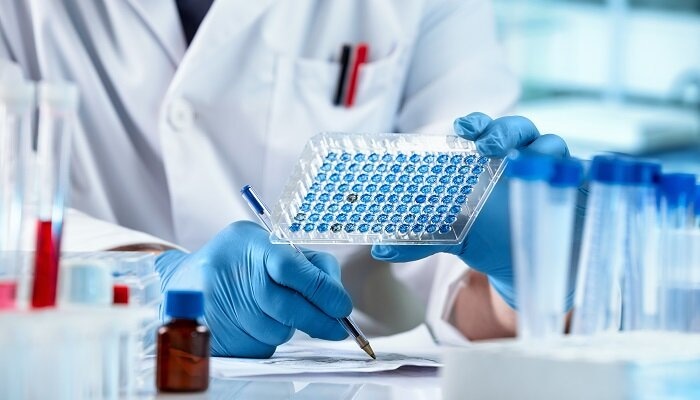The human immune system operates in a constant, silent hum orchestrated by a complex interplay of cells, molecules, and immunological processes. Understanding this landscape is fundamental to medical diagnosis and therapeutic intervention. One potent tool illuminating this territory is the Enzyme-Linked Immunosorbent Assay or ELISA.Â
When faced with diagnostic uncertainties, ELISA shines as a source of clarity, providing conclusive answers. Its swift and exact identification of infectious agents accelerates diagnostic processes, facilitating the development of targeted treatment strategies. Additionally, it proves invaluable for researchers searching into the mystery of autoimmune diseases. It accurately pinpoints the antigens fueling inflammatory cascades, unraveling the complexities of these conditions. Concurrently, ELISA is an enlightening tool for scientists mapping the nuanced landscape of human health, revealing the dynamic interplay between hormones and proteins and highlighting the essential equilibrium crucial for overall well-being.
This blog post will explain ELISA and its relevance, explore its applications in different fields and scenarios, and discover its advantages and limitations. After reading, you’ll better understand this assay and its role in efficient immunological testing. Should you want more information, this company provides a comprehensive overview. Â
Understanding ELISAÂ
ELISA is a powerful investigative tool used to analyze dynamic interactions within the immune system. It’s time to explore the fundamental steps of this analytical tool to understand its potency.
- Setting the stage – The journey begins with immobilizing specific antigens onto the surface of a microplate. These antigens, whether infectious agents or specific molecules, become the focal points of the subsequent analysis.Â
- Introducing the agents – Next, introduce pre-labeled antibodies. Each antibody links to an enzyme, often horseradish peroxidase, amplifying the signal. These antibodies bind to their complementary antigens with remarkable specificity, forming stable complexes.
- Amplifying the signal – Adding a substrate illuminates the immunological interactions. The enzyme linked to the bound antibodies specifically targets and catalyzes the conversion of the substrate, generating a detectable product, typically a color change.
- Quantifying the performance – The intensity of the generated signal, measured by a plate reader, directly reflects the concentration of the designated antigen in the original sample. The brighter the signal, the more abundant the antigen.Â
By dissecting these core steps, you can appreciate the versatility of ELISA. Different formats – direct, indirect, and sandwich – adapt the protocol to diverse objectives. Whether revealing the presence of pathogens, identifying autoantibodies, or recognizing hormone levels, this assay provides a nuanced and quantitative analysis of the complex immunological landscape.Â
Applications Of ELISAÂ
ELISA is a versatile investigative platform that navigates the diverse terrain of immunological inquiry. Here are its varied utilizations:Â
- Diagnosing and monitoring infectious diseases – ELISA is a rapid and accurate diagnostic weapon against infectious agents. Whether facing viral invaders like HIV and Hepatitis B, bacterial foes, or parasitic threats, this tool pinpoints their presence with remarkable specificity. This process facilitates timely diagnoses and enables monitoring of antibody levels, a crucial metric for tracking treatment efficacy and disease progression, ultimately optimizing patient care.
- Unveiling autoimmune disruptions – This tool functions as a meticulous investigator, revealing the concealed culprits—autoantibodies—that aim at the body’s tissues. Whether it’s the inflammatory dynamics in rheumatoid arthritis or the autoimmune complexities in lupus, ELISA discerns these aberrant molecules, facilitating early diagnosis and informing targeted therapies. By accurately measuring specific autoantibodies, this assay paints a detailed picture of disease activity, enabling clinicians to navigate flares effectively and enhance the quality of life for patients.Â
- Calibrating the biochemical landscape – ELISA transcends the domain of infectious and autoimmune landscapes, skillfully navigating the nuanced dance of hormones and proteins. It functions as an exact analytical guide, methodically measuring the levels of these biochemical actors in one’s well-being. Whether it’s monitoring insulin fluctuations in diabetes patients, uncovering hormone imbalances in metabolic disorders, or discerning the gradual rise of pregnancy hormones like hCG, this quantitative comprehension offers essential insights into physiological processes, exposing disproportions contributing to various conditions and ultimately paving the way for personalized treatment strategies.Â
ELISA’s applications untangle a hidden thread within the human defense system. It empowers both diagnosis and disease management. With its versatility and precision, this assay remains a cornerstone in immunology, continuously evolving to illuminate the ever-shifting environment of human wellness. Â
Advantages And Limitations Of ELISAÂ
Despite its powerful analytical prowess, this assay, like any tool, has strengths and limitations. Understanding these aspects is crucial for harnessing its full potential and navigating its constraints.Â
Advantages:Â
- Sensitivity and specificity – ELISA shines with its remarkable ability to detect minute quantities of selected antigens (sensitivity) while discriminating exactly between closely related molecules (specificity). This accuracy underpins reliable diagnoses and accurate quantifications.Â
- Versatility – Unlike single-use tools, this tool adapts to diverse tasks. Its various formats cater to a wide range of subjects, from infectious agents to hormones, offering a flexibility unmatched by many other techniques.
- Quantitative power – ELISA provides correct measurements of concentrations, enabling clinicians and researchers to track disease progression, monitor treatment efficacy, and explore deeper biochemical processes.Â
- Relative ease of use – This assay offers a relatively straightforward protocol compared to some complex immunological techniques. Automated plate readers further enhance its accessibility and throughput.Â
- Affordability and scalability: ELISA’s cost-effectiveness, particularly in high-throughput settings, makes it accessible to a more comprehensive range of laboratories and research initiatives.Â
Limitations:Â
- Cross-reactivity – While highly specific, this application is not immune to potential cross-reactivity, where antibodies may bind to similar but non-target molecules. This diagnostic device can lead to false-positive results and requires careful control measures.Â
- Time requirement – Although faster than some techniques, ELISA still involves multiple steps and incubation times, impacting turnaround time for results, especially in clinical settings demanding rapid diagnoses.Â
- Technical challenges – Despite its relative ease of use, the tool involves precise pipetting, washing, and incubation protocols. Inaccurate techniques or suboptimal reagents can affect results, necessitating proper training and quality control measures.Â
- Sample complexity – ELISA sensitivity can be affected by complex sample matrices, particularly in biological fluids. Pre-treatment steps may be required to purify samples and enhance accuracy.Â
- Limited multiple analyte detection – While some advancements allow for multiplexing, this assay typically analyzes one aim per test. This approach may necessitate multiple assays for different analytes in complex investigations.Â
By understanding both the benefits and restrictions of ELISA, researchers and clinicians can leverage its potency for accurate diagnoses, quantitative analyses, and diverse applications while acknowledging its limitations and implementing appropriate measures to mitigate them. Â
Final ThoughtsÂ

ELISA calls upon the future of the medical community, where each quantified molecule holds a fragment of a larger story waiting to be unraveled. With the industry embracing its precision, it’s writing a transformative script for healthcare—one revelation, one insightful test at a time. As you peer into this future, ELISA invites you to be part of the narrative and explore its pivotal role in understanding the immune system’s possible ability to combat rare and debilitating diseases, such as cancer. Consider how this precision can redefine personalized care, profoundly impacting the journey toward a robust tomorrow. Â


















